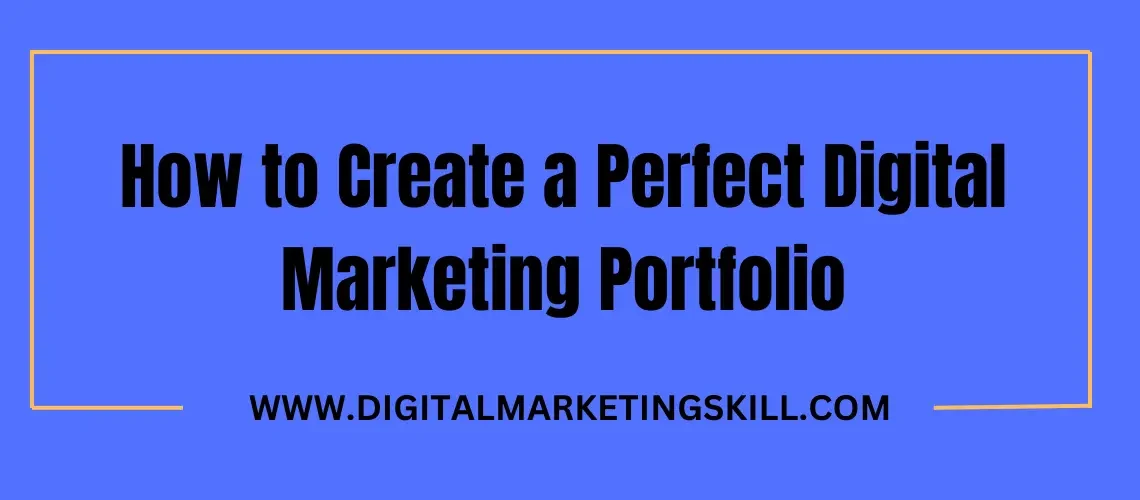Looking to land your dream job in digital marketing? Or maybe you’re a freelancer seeking new clients? Either way, having a solid digital marketing portfolio is essential.
It’s your chance to showcase your skills, experience, and achievements in a way that resonates with potential employers or clients. An online marketing portfolio is a curated collection of work samples, projects, or achievements that showcase an individual’s skills, expertise, and accomplishments.
In this post, we’ll guide you through the process of creating a compelling digital marketing portfolio that highlights your unique talents and gives you a competitive edge. From curating your best work samples to presenting them effectively, we’ve got you covered with practical tips and examples that’ll make your portfolio shine.
So let’s get started
What is a Marketing Portfolio?

A marketing portfolio is a collection of materials that showcase a marketing professional’s skills, experience, and achievements. It is typically used by marketing professionals, such as marketing managers, brand managers, digital marketers, content marketers, and social media marketers, to demonstrate their expertise and capabilities to potential employers or clients.
Why You Need a Marketing Portfolio
Get 50% Discount to Master ALL Aspects of Digital Marketing That Can Earn You $2,500 - $5,000 a month (Even if you are a complete beginner!)
Our students that intentionally implement what they learn from our digital marketing course make back the entire course fee within a single month or more after completing our course because our course gives them many income generating options with unlimited earning potential with no age or location barrier. The best part is no technical skills are required.
An opportunity to change your lifestyle and make money working from anywhere in the world. The results our students get from our digital marketing course prove this could be applied to any market or country and that it is designed for any skill level and work background.
*By signing up, you agree to our privacy policy and terms of service.
A marketing portfolio is essential in the field of marketing because it helps you to demonstrate your capabilities, differentiate yourself in a competitive market, and communicate your value to potential employers or clients.
Let’s see some of the reasons a digital marketing portfolio is important:
1. Showcasing Skills and Projects
A marketing portfolio serves as a tangible representation of your skills, past projects, and accomplishments, allowing potential employers or clients to assess your capabilities before contacting you.
2. Standing Out in a Competitive Market
In today’s competitive job market, having a portfolio sets you apart from other candidates by providing concrete evidence of your experience and expertise, helping you stand out among many resumes that will be submitted when applying for a specific job.
3. Demonstrating Value to Employers
A well-curated marketing portfolio enables you to effectively communicate your value to employers or clients by showcasing successful outcomes of past projects, your creativity skills, and your problem-solving abilities if you get employed.
Before you can create your marketing portfolio, you need to learn marketing skills. It is essential for professionals in the field to effectively strategize, execute, and optimize marketing campaigns to achieve business objectives. All you need to do is acquire and hone relevant digital marketing skills by enrolling in some or all of the courses to get started.
What to Include in a Marketing Portfolio
Now that you are ready to create a marketing portfolio, you need to know what are those components that should be included to make your portfolio stand out:
1. Short Biography
If there’s one part that will tell the reader what to expect in the portfolio, it is this part. The brief introduction guides viewers through your portfolio, highlighting your interests, skills, experience, personal qualities, and showcasing your value proposition to potential clients or employers.
2. Contact Information
When you have your contact on your portfolio, it will make it easy for potential clients or employers to reach out to you. This can be through the phone number, email address, and links to your social media accounts that you include in your portfolio. The contact details will be the medium where information will be passed to you on what to do when applying for jobs.
3. Professional Headshot
A good professional headshot conveys professionalism, aligns with your brand’s personality, and sets the right tone for your portfolio. Make sure you have a good image for your profile that can represent how you want people to perceive your brand.
4. Work Samples
A work sample is a combination of your previous work. To visually represent your marketing projects and achievements, you should showcase examples of your best work in digital formats, such as PDFs, digital images, screenshots or links to web pages. This will allow the clients to preview what you have done, and the skills you possess.
5. Results and Impact
It is not enough to just include a work sample on your portfolio. You have to be able to clearly outline the results and impact of each project, including specific numbers and measurable outcomes to demonstrate the effectiveness of your work.
6. Testimonials
Incorporate testimonials from previous colleagues, managers, or companies to build credibility, establish reliability, and make a strong first impression on potential employers or clients.
A good testimonial will help a client trust your brand and also give them confidence that you are capable of handling the task ahead and that you can deliver too.
When you incorporate some of these elements into your marketing portfolio, you can effectively showcase your skills, achievements, and expertise, differentiate yourself in the industry, and attract new opportunities in the field of marketing.
How to Create a Marketing Portfolio
To create a marketing portfolio, follow these steps based on the insights from the provided sources:
1. Choose a Hosting Platform
Select an online hosting platform like Wix, Journo, or Canva to host your portfolio website. These user-friendly platforms provide a range of customizable templates that allow you to design your portfolio website without coding skills. With intuitive interfaces and design flexibility, these hosting platforms make it easy to showcase your work professionally and highlight your skills and accomplishments in the marketing field to potential employers or clients.
2. Outline Your Site Map
When developing your marketing portfolio, it’s crucial to strategize the layout of your website by mapping out the content for each page. Consider including sections like work samples to showcase your projects, case studies to demonstrate your expertise, testimonials to build credibility, and an “About Me” page to introduce yourself professionally. These key elements allow you to create a well-structured portfolio that effectively presents your skills, experience, and achievements to potential employers or clients, making a strong impression and highlighting your capabilities in the marketing industry.
3. Include Contact Information
Ensure your contact information is easily accessible on every page of your portfolio website to facilitate communication with potential employers or clients. This practice also benefits SEO and increases visibility.
4. Create Content
Write compelling content for each page of your portfolio website, and focus on creating engaging and impactful narratives that highlight your skills, accomplishments, and projects effectively. A good storytelling format can tailor your messaging to resonate with your target audience, showcasing your expertise and communicating your unique value proposition. It’s beneficial to seek feedback from peers, mentors, or industry professionals to refine your content, ensuring clarity, relevance, and professionalism.
5. Showcase Achievements
When showcasing achievements in your marketing portfolio, emphasize your notable successes and accomplishments to demonstrate your expertise and track record of delivering results. Clearly articulate your problem-solving skills by showcasing how you have overcome challenges and achieved objectives in previous projects.
5. Incorporate Visuals
When adding visuals to your marketing portfolio, prioritize using captivating graphics and images that are relevant and visually appealing to enhance the overall presentation of your website. High-quality visuals can elevate the way your portfolio will appeal, making it more engaging and memorable for visitors. Therefore, it’s essential to steer clear of low-quality or irrelevant images that could diminish the professionalism and impact of your work.
6. Regular Updates
Consistent updates to your portfolio website are essential to keep it relevant, engaging, and optimized for search engines. When you regularly add new projects, achievements, or blog posts, you demonstrate ongoing activity and growth in your marketing skills and experience. This will allow your clients to see your previous work to date, and make them trust you that your site is active and valuable and that you are capable of handling the project and delivering the results.
Marketing Portfolio Examples
1. SEO and Digital Marketing Portfolio
The great aspect of SEO and a marketing portfolio lies in their ability to complement each other effectively.
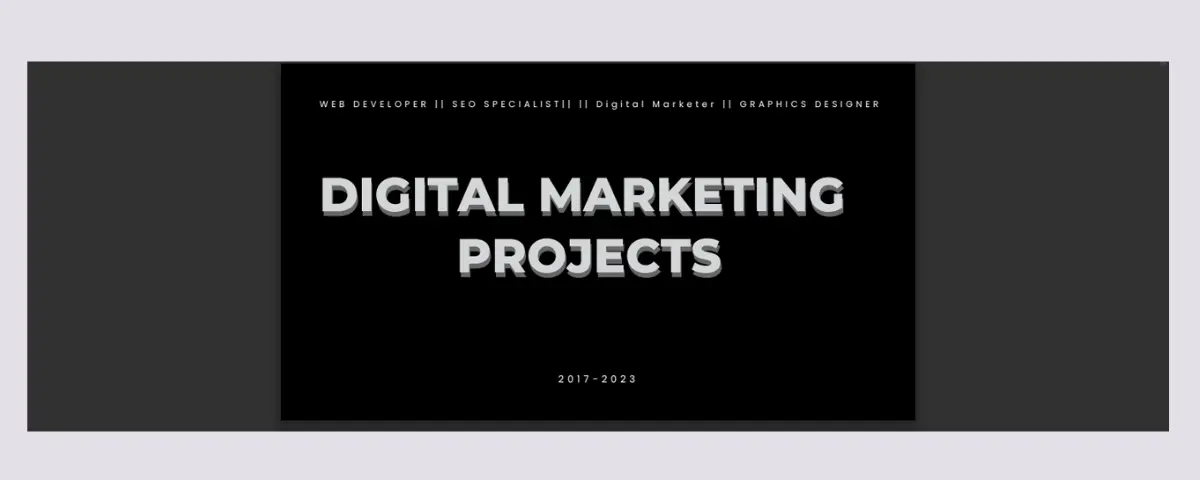
A well-crafted marketing portfolio serves as a visual representation of one’s skills, achievements, and expertise in the marketing field.
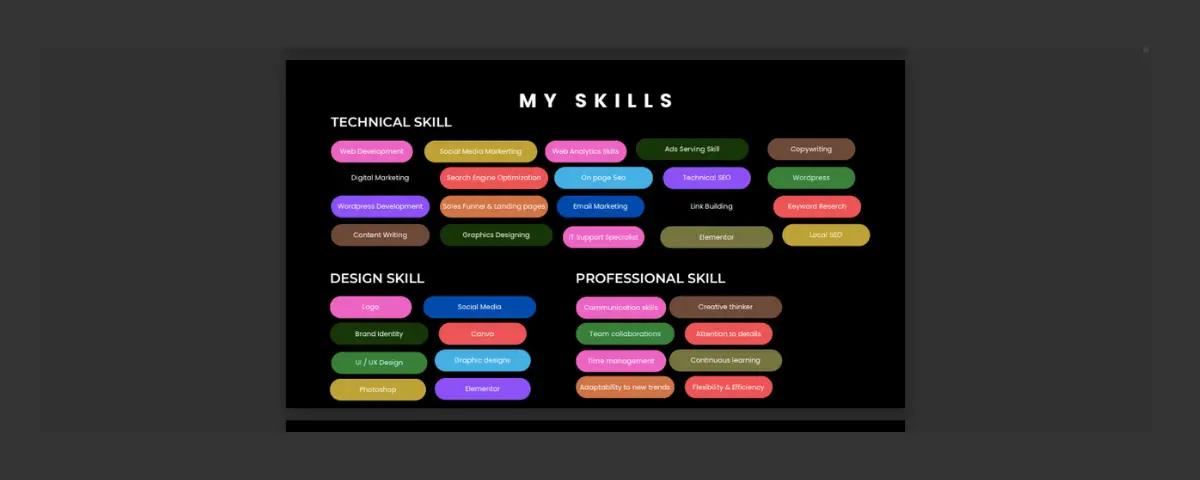
2. Social Media Manager Portfolio
The great aspect of a Social Media Manager portfolio lies in its ability to serve as a comprehensive showcase of one’s expertise, past successes, and unique approach to social media strategy.
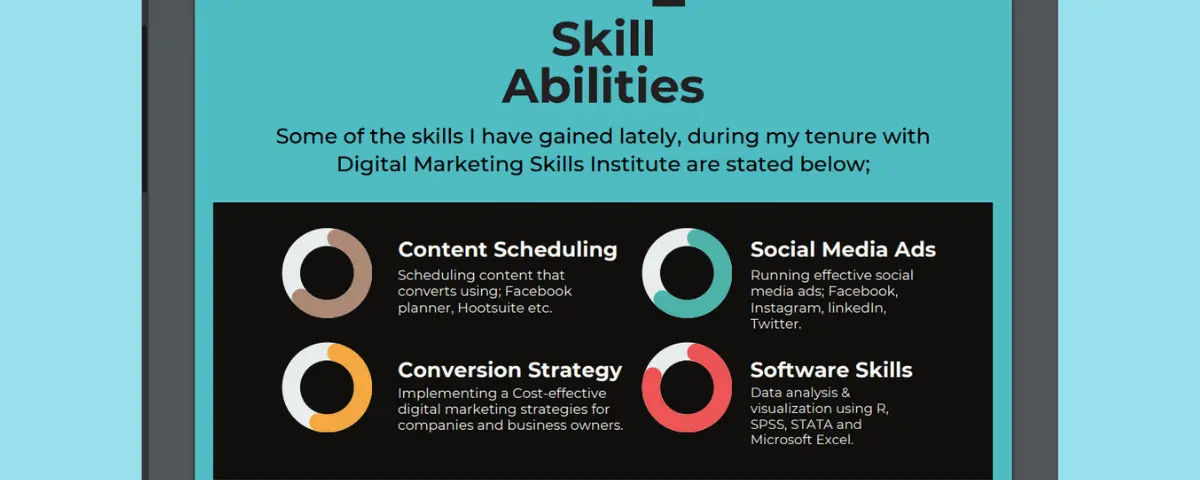
These portfolios not only display creative prowess but also provide evidence of a data-driven approach to social media management, which is increasingly valued by clients.
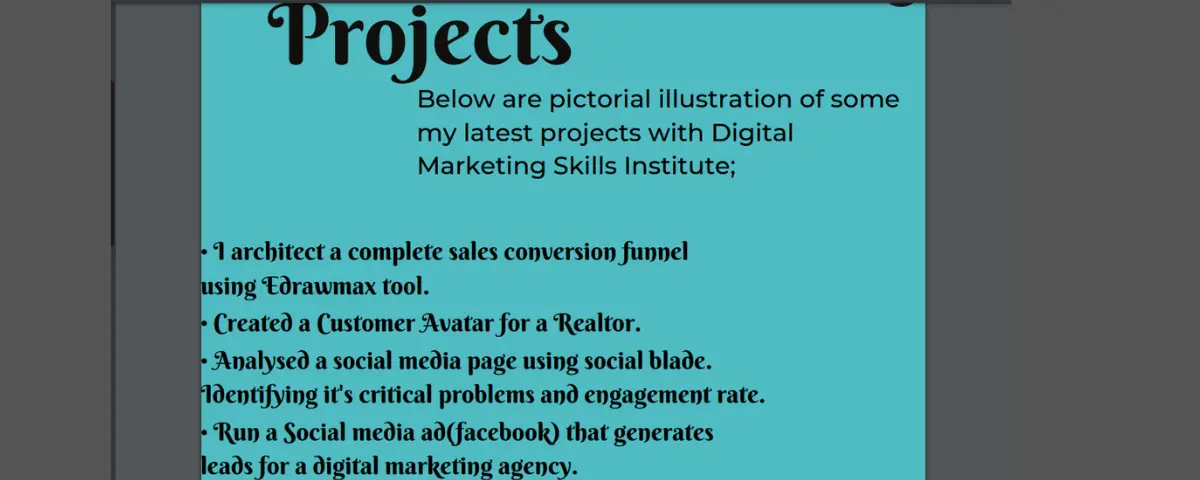
How to Create a Marketing Portfolio Without Experience
Creating a marketing portfolio without prior professional experience can be challenging, but it’s still possible to create an impressive portfolio that showcases your skills and passion for marketing.
Here are some tips to create a good portfolio:
1. Highlight relevant coursework or academic projects
If you’re a student or recent graduate, include marketing-related assignments, projects, or case studies that demonstrate your knowledge and abilities in areas like market research, campaign planning, content creation, or data analysis in your marketing portfolio.
2. Complete online marketing certifications
Obtaining online marketing certifications from reputable platforms like Digital Marketing Skill Institute (DMSI) by enrolling in some or all of the courses in digital marketing, social media marketing, or content marketing showcases your expertise and dedication to professional growth. These certifications validate your skills, knowledge, and proficiency in key areas of digital marketing, enhancing your credibility and marketability in the industry.
By investing in continuous learning and earning recognized certifications, you not only stay current with industry trends but also demonstrate your commitment to excellence and ongoing development in the dynamic field of marketing.
3. Create hypothetical marketing campaigns
Develop comprehensive marketing campaign proposals or plans for real companies or products, including market analysis, target audience profiles, branding strategies, marketing channels, and measurable goals. By developing these comprehensive campaigns, you showcase your strategic thinking, creativity, and ability to design effective marketing strategies tailored to specific business needs.
4. Contribute to blogs or online publications
Writing guest posts, articles, or blog entries related to marketing trends, strategies, or industry insights can help you showcase your skills to your potential employer. These writing samples showcase your communication skills and industry knowledge about the field and position you for marketing opportunities.
5. Volunteer or intern
As a beginner with no experience, you should seek out internships, volunteer roles, or pro bono work with businesses, or student organizations to gain hands-on marketing experience and materials for your portfolio. These hands-on opportunities allow you to apply theoretical knowledge in real-world settings, hone your skills, and build a portfolio showcasing your actual work and achievements.
6. Create a portfolio website or online presence
Develop a professional online portfolio website or presence on platforms like Behance or Dribble to showcase your work in a visually appealing and organized manner. An online presence not only serves as a digital resume but also demonstrates your creativity, professionalism, and attention to detail, making a strong impression and enhancing your visibility in the competitive field of marketing.
Marketing Portfolio Best Practices
1. Tell a Story
Your portfolio should not just be a random collection of work samples. Instead, curate and organize your pieces in a way that tells a cohesive story about your skills, experience, and approach to marketing.
2. Focus on Results
Quantify the impact of your marketing campaigns or projects by including metrics such as increased website traffic, lead generation, sales figures, or social media engagement. Employers want to see the tangible results you have delivered.
3. Highlight Your Process
In addition to showcasing the end products, include materials that illustrate your strategic thinking and process, such as market research, campaign plans, or creative briefs.
4. Tailor Your Portfolio
Customize your portfolio for each job or client you’re targeting. Highlight the most relevant work samples and achievements that align with their specific needs or industry.
5. Use Visuals Effectively
Marketing is a visual field, so ensure your portfolio is visually appealing and easy to navigate. Use high-quality images, graphics, and layouts that showcase your design skills.
6. Keep It Updated
Regularly update your portfolio with your latest and most impressive work. Potential employers or clients will want to see your most recent achievements and skills.
Create Your Marketing Portfolio
Creating a marketing portfolio is a powerful tool for showcasing your skills, achievements, and expertise in the field of marketing. A well-structured marketing portfolio highlights your capabilities and also sets you apart in a competitive market, helping you attract new opportunities and advance your career in the marketing field. Start building your impressive marketing portfolio today, and watch your professional career progress and get better opportunities.
Marketing Portfolio FAQ
Do Marketing Professionals need a portfolio?
Yes, marketing professionals can greatly benefit from having a portfolio. A marketing portfolio serves as a visual representation of their skills, achievements, and expertise in the field. It helps professionals stand out from the competition, showcase their work to potential employers or clients, and demonstrate their capabilities effectively.
What are the benefits of a marketing portfolio?
The benefits of a marketing portfolio include:
- Standing out in a competitive job market.
- Showcasing your skills and achievements effectively.
- Building credibility and trust with potential clients or employers.
- Opening up new career opportunities and collaborations.
- Demonstrating your expertise and professionalism in the marketing field.
What is the main purpose of a portfolio?
The main purpose of a portfolio is to serve as a curated collection of your best work, projects, and achievements. It acts as a visual representation of your skills and expertise, helping you demonstrate your capabilities, attract opportunities, and differentiate yourself in your industry.
More resources
What is a Digital Marketing Strategist and How to Become One

